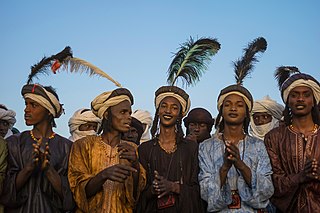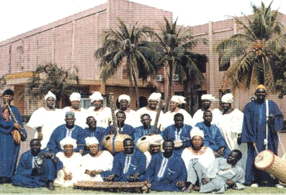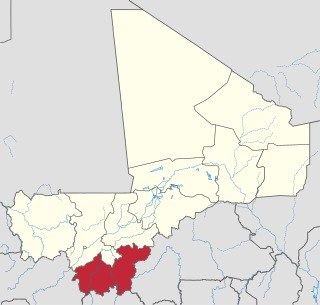
The Fula, Fulani, or Fulɓe people is an ethnic group that is widely dispersed across Africa. They are found mainly in 20 countries, mainly those of Western and Central Africa. They are also sparsely found in Northern and Eastern Africa.

The music of Mali is, like that of most African nations, ethnically diverse, but one influence predominates: that of the ancient Mali Empire of the Mandinka. Mande people make up around 50% of Mali's population; other ethnic groups include the Fula (17%), Gur-speakers 12%, Songhai people (6%), Tuareg and Moors (10%).

The Mandinka or Malinke are a West African ethnic group primarily found in southern Mali, the Gambia, southern Senegal and eastern Guinea. Numbering about 11 million, they are the largest subgroup of the Mandé peoples and one of the largest ethnic-linguistic groups in Africa. They speak the Manding languages in the Mande language family, which are a lingua franca in much of West Africa. Virtually all of Mandinka people are adherent to Islam, mostly based on the Maliki jurisprudence. They are predominantly subsistence farmers and live in rural villages. Their largest urban center is Bamako, the capital of Mali.

Sikasso Region is the southernmost region of Mali. The region's capital city, Sikasso, is the country's second-largest city. Major ethnic groups include the Senoufo, known for masks and reverence for animals, the Samago, known for being Mali's best farmers, and the main ethnic group in Mali, the Bambara people.

Oumou Sangaré is a Grammy Award-winning Malian Wassoulou musician of Fulani or Fula descent. She is often referred to as "The Songbird of Wassoulou". Wassoulou is a historical region south of the Niger River, where the music descends from age-old traditional song, often accompanied by a calabash.

Wassoulou is a genre of West African popular music named for the Wassoulou cultural area.

Samory Toure, also known as Samori Toure, Samory Touré, or Almamy Samore Lafiya Toure, was a Mandinka Muslim cleric, military strategist, and founder of the Wassoulou Empire, an Islamic empire that was stretched across present-day north and eastern Guinea, north-eastern Sierra Leone, southern Mali, northern Côte d'Ivoire and part of southern Burkina Faso.

Sikasso is a city in the south of Mali and the capital of the Sikasso Cercle and the Sikasso Region. It is Mali's second largest city with 225,753 residents in the 2009 census.

The Wassoulou empire, sometimes referred to as the Mandinka Empire, was a short-lived West African state that existed from roughly 1878 until 1898, although dates vary from source to source. It spanned from what is now southwestern Mali and upper Guinea, with its capital in Bissandugu; it expanded further south and east into northern Ghana and Ivory Coast before its downfall.

The Kénédougou Kingdom,, was a pre-colonial West African state established in the southeastern portion of present-day Mali, as well as parts of northern Cote d'Ivoire and western Burkina Faso.
The Mandingo Wars were a series of conflicts from 1883 to 1898 between France and the Wassoulou Empire of the Mandingo people led by Samori Ture. Comparatively, the French faced serious resistance by the Mandinka, as they were able to make use of firearms and tactics that impeded French expansion in the area. The French were ultimately triumphant and established dominance over Mali, Guinea and the Ivory Coast.

Articles related to Mali include:

The Yalunka, or Dialonké, are a Mandé-speaking people and the original inhabitants of Futa Jallon, a mountainous region in Guinea, West Africa. The Yalunka people live primarily in Guinea, particularly in Faranah, while smaller communities are found in Kouroussa. Additional Yalunka are also located in northeastern Sierra Leone, southeastern Senegal, and southwestern Mali.

Yanfolila Cercle is an administrative subdivision of the Sikasso Region of southern Mali. The administrative center (chef-lieu) is the town of Yanfolila.
Wassoulou-Ballé is a rural commune in the Cercle of Yanfolila in the Sikasso Region of southern Mali. The administrative center (chef-lieu) of the commune is the town of Yanfolila. The town is also the administrative center of the cercle. It lies 272 km west of Sikasso, 164 km south of Bamako and 23 km from the border with Guinea. The commune covers an area of 1,594 square kilometers and includes the town of Yanfolila and 29 villages. In the 2009 census it had a population of 51,727.
Yallankoro-Soloba is a rural commune in the Cercle of Yanfolila in the Sikasso Region of southern Mali. The commune covers an area of 285 square kilometers and includes 8 villages. In the 2009 census it had a population of 11,722. The village of Soloba, the administrative center (chef-lieu) of the commune, is 32 km west of Yanfolila and only around 4 km from the Sankarani River that marks the border with Guinea.
Séré Moussa Ani Samou is a rural commune in the Cercle of Yanfolila in the Sikasso Region of southern Mali. The commune covers an area of 552 square kilometers and includes 15 villages. In the 2009 census it had a population of 18,088. The village of Siékorolé, the administrative center (chef-lieu) of the commune, is 20 km northwest of Yanfolila.
Tagandougou is a rural commune in the Cercle of Yanfolila in the Sikasso Region of southern Mali. The commune covers an area of 614 square kilometers and includes 7 villages. In the 2009 census it had a population of 5,775. The village of Binko, the administrative center (chef-lieu) of the commune, is 52 km north of Yanfolila on the western side of the Sélingué Dam.
Kiniéran is a town and sub-prefecture in the Mandiana Prefecture in the Kankan Region of eastern Guinea. As of 2014 it had a population of 37,944 people.
The Batè Empire was a pre-colonial state centred on Kankan in what is today Guinea. Founded by Mandinka and Soninke people as an Islamic merchant state in the 16th century, it survived until the late 19th century when it was conquered first by Samori Ture and then incorporated into French Guinea.













